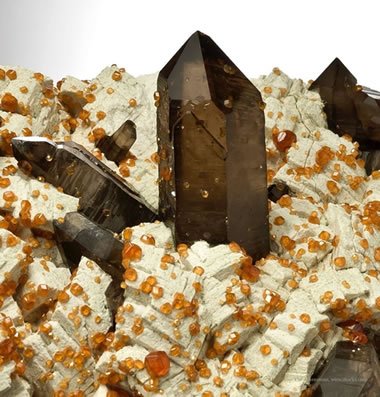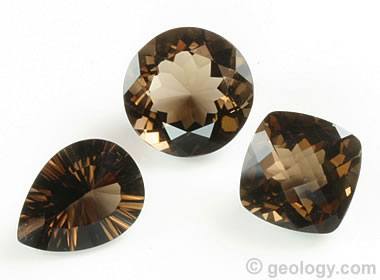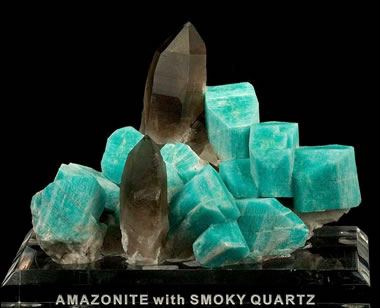Home » Gemstones » Smoky Quartz
Smoky Quartz
A brown color-variety of the mineral quartz.
Author: Hobart M. King, PhD, GIA Graduate Gemologist

Smoky Quartz Crystals: A group of smoky quartz crystals on a bed of feldspar and peppered by tiny orange spessartine garnet crystals. This specimen is from the Wushan Spassartine Mine, Fujian Province, China. The crystal group is approximately 18 x 13.5 x 8.0 centimeters in size. Specimen and photo by Arkenstone / www.iRocks.com.
What is Smoky Quartz?
Smoky quartz is a color-variety of crystalline quartz. It ranges from a light yellowish brown to a brown that is so dark that it appears to be black. Less-desirable specimens have a grayish brown color. When cut as a gem, stones with an orangish brown to a reddish brown color are preferred by many people.
Smoky quartz is a relatively inexpensive gem material because it is abundant, found in many locations, and its brown color is not currently in high demand. It is often found in large crystals of excellent transparency with few inclusions.
The color of smoky quartz is produced when natural radiation, emitted from the surrounding rock, activates color centers around aluminum impurities within the crystalline quartz. Amethyst forms in a similar way, from the activation of color centers around iron impurities.
Table of Contents
 What is Smoky Quartz? What is Smoky Quartz? Treatments Treatments Uses of Smoky Quartz Uses of Smoky Quartz Physical Properties of Smoky Quartz Physical Properties of Smoky Quartz Geologic Occurrence Geologic Occurrence Notable Localities Notable Localities |
Treatments
Some specimens of rock crystal can be given the color of smoky quartz by irradiation in a laboratory. The exposure can be controlled to vary the color of the product. This is not often done in a lab because natural smoky quartz is inexpensive and abundant relative to demand. For the same reason, synthetic smoky quartz is seldom produced. Natural smoky quartz with a very dark color is sometimes heated to lighten its color.

Faceted smoky quartz: Rich brown faceted stones of smoky quartz, all cut from material mined in Brazil. From left to right they are a 5.28 carat pear concave cut measuring 14.84 x 11.01 millimeters; a 7.4 carat round measuring 14.09 millimeters; and a 7.16 carat cushion checkerboard cut measuring 12.19 x 12.15 millimeters.
Uses of Smoky Quartz
Smoky quartz is faceted or cut into beads and cabochons. These gems are often used in rings, pendants, necklaces, earrings, and brooches for people who like the yellowish brown to brown color.
Smoky quartz with a dark brown color is often used in men's rings and cufflinks. During the Victorian Period, dark brown stones from the Mourne Mountains of Ireland were often used in mourning jewelry.
Because smoky quartz has a low price and large pieces are easily obtained, it is a favorite practice material of people who are learning to facet. It is also frequently used as a carving material.
As early as the 12th centry, flat pieces of smokey quartz were used in China to make eyeglasses. Some of these were used to shield the eyes from bright light. A few were worn by judges during court proceedings, to hide their facial expressions.
Physical Properties of Smoky Quartz |
|
| Chemical Classification | Silicate |
| Color | Light yellowish brown to orangish brown to reddish brown to brown so dark that it appears to be black. Many specimens are grayish. Often zoned. |
| Streak | Colorless (harder than the streak plate) |
| Luster | Vitreous |
| Diaphaneity | Transparent to translucent |
| Cleavage | None - typically breaks with a conchoidal fracture |
| Mohs Hardness | 7 |
| Specific Gravity | 2.6 to 2.7 |
| Diagnostic Properties | Conchoidal fracture, glassy luster, hardness, brownish color |
| Chemical Composition | SiO2 |
| Crystal System | Trigonal |
| Uses | Faceted gemstones, cabochons, beads, carvings, spheres |
Physical Properties of Smoky Quartz
Smoky quartz, amethyst, citrine, ametrine, rose quartz, and lemon quartz are all color-varieties of the mineral quartz. Other than color, they all have nearly identical properties. The properties of smoky quartz are provided in the table.

Smoky Quartz and Amazonite: A cluster of bluish green amazonite and dark brown smoky quartz crystals from the Smoky Hawk Claim, Crystal Peak, Teller County, Colorado. The crystal cluster is approximately 11 x 8.2 x 6.3 centimeters in size. Specimen and photo by Arkenstone / www.iRocks.com.
Geologic Occurrence
Smoky quartz is mainly found in quartz veins and pegmatite dikes that cut across igneous and metamorphic rocks. Well-formed crystals are often found in cavities of igneous and metamorphic rocks along the margins of a pegmatite. Smoky quartz formed at lower temperatures is sometimes found in fractures of sedimentary and metamorphic rocks with no known igneous association.
Radioactive mineral deposits in many parts of the world are associated with very dark smoky quartz. The very dark quartz at these locations was probably colored by emissions from the radioactive minerals.
| Smoky Quartz Information |
|
[1] Science and Civilization in China: by Joseph Needham, a book series published by Cambridge University Press, Volume IV, 468 pages, 1962. |
Notable Localities
Brazil is the current source for most of the world’s smoky quartz used in jewelry. Madagascar is another important producer of smoky quartz in commercial quantities.
Smoky quartz is the national gem of Scotland, where it is called “cairngorm” after the Cairngorm Mountains. Near Pike’s Peak, Colorado, there are deposits of smoky quartz associated with amazonite that have become world famous with mineral collectors for their excellent crystals of both minerals. On May 31, 1985, smoky quartz was designated as the “official state gem” of New Hampshire. Other localities of note include Russia, Ukraine, and Switzerland.
| More Gemstones |
 |
Tourmaline |
 |
Fancy Sapphires |
 |
Diamond |
 |
Canadian Diamond Mines |
 |
Birthstones |
 |
Pictures of Opal |
 |
Fire Agate |
 |
Blue Gemstones |

Find Other Topics on Geology.com:

|

| ||

|

| ||

|

| ||

|

|
